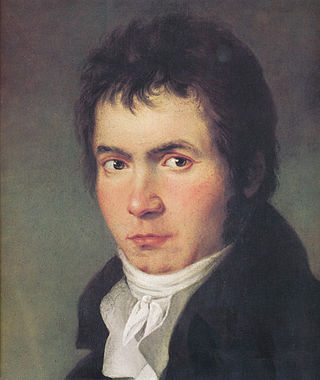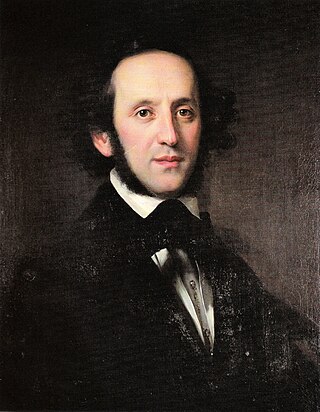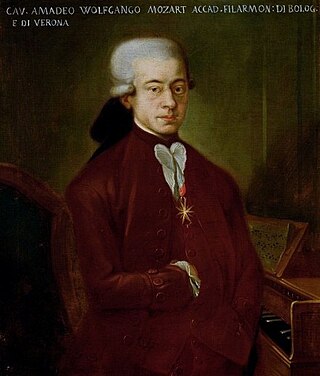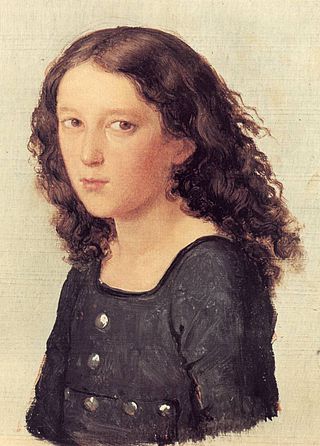The sonata form is a musical structure generally consisting of three main sections: an exposition, a development, and a recapitulation. It has been used widely since the middle of the 18th century.

The Violin Concerto in D major, Op. 61, was written by Ludwig van Beethoven in 1806. Its first performance by Franz Clement was unsuccessful and for some decades the work languished in obscurity, until revived in 1844 by the then 12-year-old violinist Joseph Joachim with the orchestra of the London Philharmonic Society conducted by Felix Mendelssohn. Joachim would later claim it to be the "greatest" German violin concerto. Since then it has become one of the best-known and regularly performed violin concertos.

The Piano Concerto in A minor, Op. 54, by the German Romantic composer Robert Schumann was completed in 1845 and is the composer's only piano concerto. The complete work was premiered in Dresden on 4 December 1845. It is one of the most widely performed and recorded piano concertos from the Romantic period.

The Piano Concerto No. 5 in E-flat major, Op. 73, known as the Emperor Concerto in English-speaking countries, is a piano concerto composed by Ludwig van Beethoven. Beethoven composed the concerto in 1809 under salary in Vienna, and he dedicated it to Archduke Rudolf, who was his patron, friend, and pupil. Its public premiere was on 28 November 1811 in Leipzig, with Friedrich Schneider as the soloist and Johann Philipp Christian Schulz conducting the Gewandhaus Orchestra. Beethoven, usually the soloist, could not perform due to declining hearing.

Beethoven's Piano Concerto No. 3 in C minor, Op. 37 is always thought to have been composed in 1800, although the year of its composition has been questioned by some contemporary musicologists. It was first performed on 5 April 1803, with the composer as soloist. During that same performance, the Second Symphony and the oratorio Christ on the Mount of Olives were also premiered. The composition was published in 1804, and was dedicated to Prince Louis Ferdinand of Prussia. The first primary theme is reminiscent of that of Mozart's 24th Piano Concerto, also in C minor.

Felix Mendelssohn's Violin Concerto in E minor, Op. 64, MWV O 14, is his last concerto. Well received at its premiere, it has remained among the most prominent and highly-regarded violin concertos. It holds a central place in the violin repertoire and has developed a reputation as an essential concerto for all aspiring concert violinists to master, and usually one of the first Romantic era concertos they learn. A typical performance lasts just under half an hour.

The Piano Concerto No. 1 in B♭ minor, Op. 23, was composed by Pyotr Ilyich Tchaikovsky between November 1874 and February 1875. It was revised in 1879 and in 1888. It was first performed on October 25, 1875, in Boston by Hans von Bülow after Tchaikovsky's desired pianist, Nikolai Rubinstein, criticised the piece. Rubinstein later withdrew his criticism and became a fervent champion of the work. It is one of the most popular of Tchaikovsky's compositions and among the best known of all piano concerti.

The Piano Concerto No. 21 in C major, K. 467, was completed on 9 March 1785 by Wolfgang Amadeus Mozart, four weeks after the completion of the previous D minor concerto, K. 466.

The Violin Concerto No. 3 in G major, K. 216, was composed by Wolfgang Amadeus Mozart in Salzburg in 1775 when he was 19 years old. In a letter to his father, Mozart called it the "Straßburg-Concert". Researchers believe this epithet comes from the motive in the third movement's Allegretto in the central section, a local dance that already had appeared as a musette-imitating tune in a symphony by Carl Ditters von Dittersdorf.

The Piano Concerto No. 2 in B-flat major, Op. 19, by Ludwig van Beethoven was composed primarily between 1787 and 1789, although it did not attain the form in which it was published until 1795. Beethoven did write a second finale for it in 1798 for performance in Prague, but that is not the finale that was published. It was used by the composer as a vehicle for his own performances as a young virtuoso, initially intended with the Bonn Hofkapelle. It was published in December 1801 as Op. 19, later than the publication in March that year of his later composition the Piano Concerto No. 1 in C major as Op. 15, and thus became designated as his second piano concerto.

Ludwig van Beethoven's Piano Concerto No. 1 in C major, Op. 15, was written in 1795, then revised in 1800. It was possibly first performed by Beethoven at his first public concert in Vienna on 29 March 1795. It was first published in 1801 in Vienna with dedication to his pupil Princess Anna Louise Barbara Odescalchi, known to her friends as "Babette".

The Piano Concerto No. 24 in C minor, K. 491, is a concerto composed by Wolfgang Amadeus Mozart for keyboard and orchestra. Mozart composed the concerto in the winter of 1785–1786, finishing it on 24 March 1786, three weeks after completing his Piano Concerto No. 23 in A major. As he intended to perform the work himself, Mozart did not write out the soloist's part in full. The premiere was in early April 1786 at the Burgtheater in Vienna. Chronologically, the work is the twentieth of Mozart's 23 original piano concertos.

Wolfgang Amadeus Mozart's Piano Concerto No. 9 in E♭ major, K. 271, known as the Jeunehomme or Jenamy concerto was written in Salzburg in 1777 when the composer was 21 years old.

The Piano Concerto No. 22 in E♭ major, K. 482, is a work for piano, or fortepiano, and orchestra by Wolfgang Amadeus Mozart, composed in December 1785.

The Piano Concerto No. 18 in B♭ major, K. 456, is a piano concerto by Wolfgang Amadeus Mozart. In Mozart's own catalogue of his works, this concerto is dated 30 September 1784.

The Concerto for Flute, Harp, and Orchestra in C major, K. 299/297c, is a concerto by Wolfgang Amadeus Mozart for flute, harp, and orchestra. It is one of only two true double concertos that he wrote, as well as the only piece of music by Mozart for the harp. The piece is one of the most popular such concertos in the repertoire, as well as often being found on recordings dedicated to either one of its featured instruments.

It is not known when Mozart completed his Concerto for Two Pianos and Orchestra in E-flat major, K. 365/316a, but research by Alan Tyson shows that cadenzas for the first and third movements are written in his and his father's handwriting on a type of paper used between August 1775 and January 1777. However, most sources, including Tyson's book Mozart: Studies of the Autograph Scores or more recently Lindeman's The Concerto: A Research and Information Guide (2006) indicate that it was composed in 1779. It is presumed that Mozart wrote it to play with his sister Maria Anna ("Nannerl"). Years later he performed it in a private concert with pupil Josepha Barbara Auernhammer.
Carl Maria von Weber wrote his Clarinet Concerto No. 1 in F minor, Op. 73 for the clarinettist Heinrich Bärmann in 1811. The piece is highly regarded in the instrument's repertoire. It is written for clarinet in B♭. The work consists of three movements in the form of fast, slow, fast. It was premiered in Munich on 13 June 1811, with Maximilian I Joseph of Bavaria in attendance.

The Piano Quartet No. 1 in G minor, Op. 25, was composed by Johannes Brahms between 1856 and 1861. It was premiered in 1861 in Hamburg, with Clara Schumann at the piano. It was also played in Vienna on 16 November 1862, with Brahms himself at the piano supported by members of the Hellmesberger Quartet. Like most piano quartets, it is scored for piano, violin, viola, and cello.

The Concerto for Piano, Violin, and Strings in D minor, MWV O4, also known as the Double Concerto in D minor, was written in 1823 by Felix Mendelssohn when he was 14 years old. This piece is Mendelssohn's fourth work for a solo instrument with orchestral accompaniment, preceded by a Largo and Allegro in D minor for Piano and Strings MWV O1, the Piano Concerto in A Minor MWV O2, and the Violin Concerto in D minor MWV O3. Mendelssohn composed the work to be performed for a private concert on May 25, 1823 at the Mendelssohn home in Berlin with his violin teacher and friend, Eduard Rietz. Following this private performance, Mendelssohn revised the scoring, adding winds and timpani and is possibly the first work in which Mendelssohn used winds and timpani in a large work. A public performance was given on July 3, 1823 at the Berlin Schauspielhaus. Like the A minor piano concerto (1822), it remained unpublished during Mendelssohn's lifetime and it wasn't until 1999 when a critical edition of the piece was available.



















